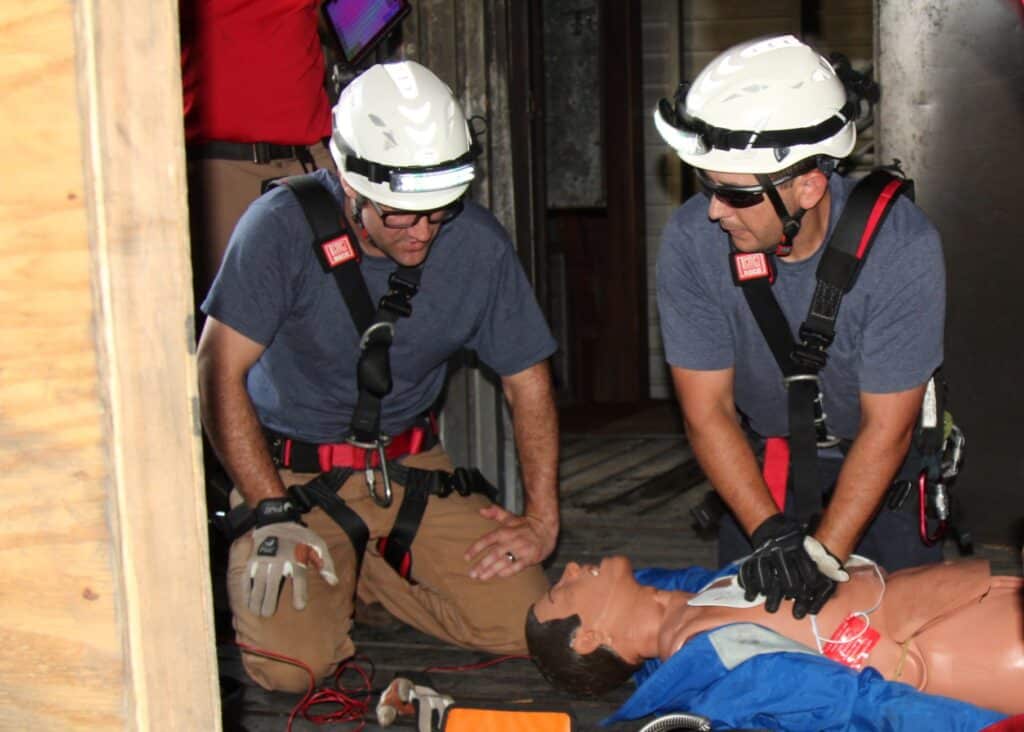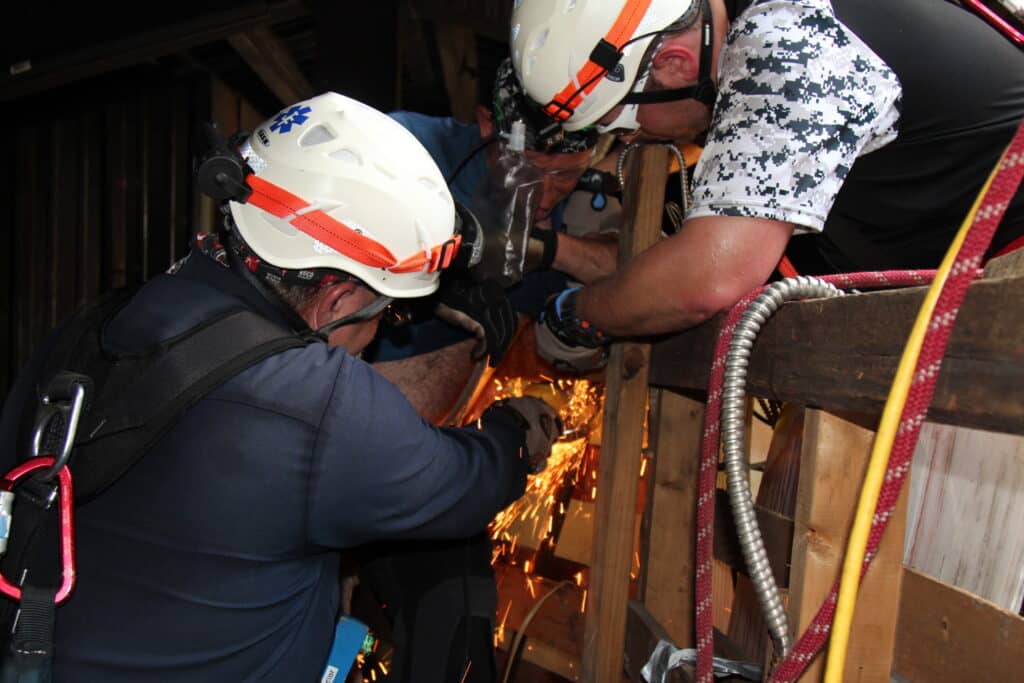Investing in your employee’s health and safety starts with Code 3 Medical Services

Industrial and manufacturing environments are essentially small cities with a multitude
of abnormal hazards with increased potential for deadly injuries. From rescue to hazmat mitigation, potential life threatening injuries will need immediate addressing and stabilizing while medical response teams work on patient access or removal. In some cases, the immediate removal of the injured may take priority over injury stabilization or treatment due
to environment hazards. In either situation, the actions of on site personnel could mean the difference between an injured worker living or dying. In most cases of trauma related deaths,
many are preventable deaths with proper and expediate first aid. Whether you work in a
industrial manufacturing facility or a simple corporate office environment, to not have
employees trained in those simplistic skill sets may leave companies with an increased
exposure of unwanted liability.
At Code 3 Medical Services, we have custom training programs to accommodate your specific
work environment. Our cadre of instructors are seasoned professional first responders with
large entities that have accumulated years of experience dealing with trauma and medical
emergencies. Code 3 Medical Services offers single day and multiple day training programs
anywhere in the Northern United States. From standard certified training classes that exceed
OSHA requirements to custom training programs, we can meet your workplace safety and first
aid needs.
Certification: None
• Time: 8 Hrs
• PreRequisite: None
• The Code 3 Medical Industrial Trauma Life Saver course prepares individuals with how
to treat potentially life threatening injuries until professional medical help arrives. The
course covers the basic tools needed and how to properly use them on co-workers OR
themselves in a time is life situation. The reality is that recognition and administering
of basic life saving skills related to traumatic injuries could be the difference between
life and a preventable death. Covering topics such as massive hemorrhaging, wound
dressing, respiratory trauma, and shock. Course includes knowledge base classroom
instruction, hands on application of tools (tourniquets, pressure bandages, chest seals,
and etc), and live reality based scenario training with the incorporation of live role
players and military grade moulage. At the end of the day clients will have a thorough
understanding of basic trauma management.
• Certification: Accredited HSI 2 Year National Certification (We are also credentialed
through the Louisiana State Bureau of EMS Certification Upon passing written/skills
testing)
• Time: Approximately 48 Hrs
• PreRequisite: None
• This innovative and reality based Emergency Medical Responder Certification course is
designed to train the lay person in emergency care of the sick and injured until more
advanced emergency care providers arrive. This class is geared to industry, law
enforcement and fire services that need emergency medical training but not to EMTBasic level or above. Class is approximately 48 hours long and is NOT simply 5 days of
video or PowerPoint. Rather, the week will integrate copious amounts of hand on
training time as well as reality based scenarios to integrate what was learned and
instill confidence in actual performance if an emergency was to occur. Students are
taught how to deal with traumatic injuries, bandaging, splinting, simple spinal
immobilization, basic life support, oxygen treatment, and emergency childbirth.
Prerequisites:
1. Must be 18 years of age.
2. Follows NREMT’s curriculum standards.
3. Certification in Basic Life Support (BLS) at the Health Care Provider Level (American
Heart Association or approved
equivalent). (INCLUDED WITH Code 3 Medical Services EMR CERTIFICATION CLASS)
• Class EXCEEDS OSHA required medical training minimums.
• Open Enrollment Registration>
Certification: Accredited HSI 2 Year National Certification
• Time: Approximately 4-6 Hrs Basic First Aid/CPR/AED
• 17-21Hrs for Advanced First Aid/CPR/AED
• PreRequisite: None
• The goal of the HSI Adult First Aid | CPR AED training program is for participants
to gain or improve knowledge and skill proficiency in adult first aid and/or CPR
AED for adult, child, and infant.
• This program includes flexible instructional tools for developing proficiency via
demonstration and prompted practice, including scenario-based problem-solving
exercises with feedback.
• HSI First Aid | CPR AED reflects the latest resuscitation science and treatment
recommendations published by the International Liaison Committee on
Resuscitation (ILCOR), and it conforms with the 2020 American Heart Association
(AHA) Guidelines Update for CPR and ECC and the annual Guidelines Update.
• Prerequisites:
1. Must be 18 years of age.
• Class EXCEEDS OSHA required medical training minimums.
Certification: Accredited 2 Year National Certification
• Time: Approximately 3-5Hrs
• Prerequisite: None
• The HSI Basic Life Support (BLS) program is for participants to gain or improve
knowledge and skill proficiency in high-quality CPR skills and teamwork for the
adult, child, and infant.
• HSI Basic Life Support (BLS) reflects the latest resuscitation science and treatment
recommendations published by the International Liaison Committee on
Resuscitation (ILCOR), and it conforms with the 2020 American Heart Association
(AHA) Guidelines Update for CPR and ECC and the annual Guidelines Update.
Continuing Education Hours Available: Emergency Medical Services (CAPCE) and
Dental Professionals (AGD/PACE).
• The intended audience is individuals who are healthcare providers (in and out of
hospital), public safety professionals in a variety of occupational settings, or individuals
enrolled in healthcare and public safety career training programs who require BLS
training.
Certification: None
• Time: 6-8Hrs
• Prerequisite: None
• This unique class incorporates basic first aid concepts and can integrate methodologies
and protocols all the way to Paramedic level patient care if needed. The class
concentrates on life threatening to extended patient care in confined spaces. From the
industrial setting to cave and austere environments, being in a tight and confined
space presents difficult challenges not normally seen in the street and urban
environment. We address challenges such as low light/darkness, limited space access,
oxygen deficient environments, patient entrapment with prolonged extrication, and
many other arenas dictated by the specific hazards of the client. The class can be basic
first aid and BLS based all the way to Advanced Life Support dependent of the
certification and licensing requirements of the client.
Certification: None
• Time: 8 Hrs
• PreRequisite: Certified EMT-I, EMT-P, RN
• ALS Intervention Concepts focuses on Advanced Airway and IV skill sets for individuals
responsible for advanced patient care. Intubation and IV techniques are a perishable
skill set that require regular hands on training to maintain proficiency. This class
focuses on the latest data and techniques to ensure individuals maintain a high
confidence level and proficiency skill set for their patients. The class incorporates the
latest advanced airway manikins which allows hands on practice of all advanced airway
adjuncts (ET, King LT, Combi Tubes, and I-Gel) as well as cricothyrotomy evolution’s. IV
teaching adjuncts are also used for hands on practice of various IV applications. “Live”
labs are also integrated into the class that cover “live” IV placement, complete airway
demonstrations, hands on practice with airway adjuncts, and complete dissection for
further education purposes.
Certification: CE Hours to be submitted to your state/national agency (Upon passing written/skills
testing)
• Approved by the Louisiana Bureau of Emergency Medical Services EMS Educational
Program. Code 3 Medical Services will submit all CE hours for clients who’s
certifications fall under the state of Louisiana.
Time: 20-40 Hrs Dependant on Certification Level
PreRequisite: Current/Valid EMR or EMT Certification
• If your staff or rescue teams hold a Emergency Medical Responder (EMR) or Emergency
Medical Technician (EMT) certification, then mandatory Continuing Education (CE) are typically
due on a yearly basis in order to keep a valid certification under many state or national
agencies like the National Registry of EMT’s (NREMT). Code 3 Medical Services currently offers
a complete CE class that meets the NREMT’s guidelines for required CE’s. This 20-40 hour class
covers the following topics:
* Anatomy & Physiology
* Trauma
* Medical
* Skills Review
* Skills Testing
The class is comprised of classroom knowledge based review, hands on skills applications, live
labs, skills review, and skills testing. In many instances, students leave our Code 3 Medical
Services CE class with greater confidence and understanding of how to better perform their
perspective roles as medical responders. Class hours and test sheets are given to
students/managers for proper submission of paperwork with their state or national agency.
• Certification: Accredited 2 Year National Certification
• Time: 6-8Hrs
• Prerequisite: None
Workplace Violence Prevention & Response:
Active Violence Emergency Response Training (AVERT) gives you the tools to
understand how to recognize warning signs, react quickly in an active shooter situation,
and learn how to control bleeding in life-threatening situations. AVERT is active shooter
response training with the addition of techniques on how to stop the bleed of victims.
AVERT provide training on how to:
• Recognize warning signs using situational awareness
• Decide whether to escape, evade, or attack during an active shooter situation
• Apply critical stop the bleed techniques
• Respond quickly and confidently in an emergency
Stop The Bleed:
• According to the Centers for Disease Control and Prevention, traumatic injury is
one of the leading causes of death for people under 50 years of age in the United
States. A large portion of those deaths are from severe bleeding – the most
treatable cause of death due to trauma. The Code 3 Medical Services integrates
the latest and new Stop Life-Threatening Bleeding procedures. This program uses
a step-by-step procedure and skill guide to provide guidance for assessing,
prioritizing, and stopping life-threatening bleeding based on scientific evidence,
national guidelines, and the consensus of experts.
• Assess the safety of the scene
• Take standard precautions using appropriate personal protective equipment
(PPE)
• Evaluate a person to determine whether they have life-threatening bleeding
• Activate EMS and/or your emergency action plan (EAP)
• Stop life-threatening bleeding by manual pressure, wound packing, and/or
applying a tourniquet
HSI Stop Life-Threatening Bleeding has been approved by the HSI Medical Advisory
Board and reviewed by the HSI Advisory Council. It reflects the latest resuscitation
science and treatment recommendations published by the International Liaison
Committee on Resuscitation (ILCOR) and conforms with the 2020 American Heart
Association (AHA) Guidelines Update for CPR and ECC and the annual Guidelines
Update.
• Certification: None
• Time: 8-10 Hrs
• PreRequisite: None
• Trauma and medical skills are a perishable skill, plain and simple. In order to stay
efficient and update, we offer a 1 to multi day training classes customized for rescue
and response teams that are conducive to specific work related injuries. Specific work
related dangers and subjects are covered with updated discussion and information,
hands on skills with related tools and gear, followed by reality based scenario training
with military grade moulage and high tech medical simulators. The end results are
response team members maintaining and performing at a higher level of proficiency
when time is of the essence. Afterwards, a detailed performance review will be written
and sent back to the client that addresses all strong points and weak points that were
observed during the training. This allows team members to focus on follow up training
to address specific weaknesses that were witnessed.

The life you save with CPR is most likely to be a loved one.
• Nearly 383,000 out-of-hospital sudden cardiac arrests occur annually, and 88 percent of cardiac arrests occur at home.
• Many victims appear healthy with no known heart disease or other risk factors.
• Sudden cardiac arrest is not the same as a heart attack.
• Sudden cardiac arrest occurs when electrical impulses in the heart become rapid or chaotic, which causes the heart to suddenly stop beating.
• A heart attack occurs when the blood supply to part of the heart muscle is blocked. A heart attack may cause cardiac arrest.